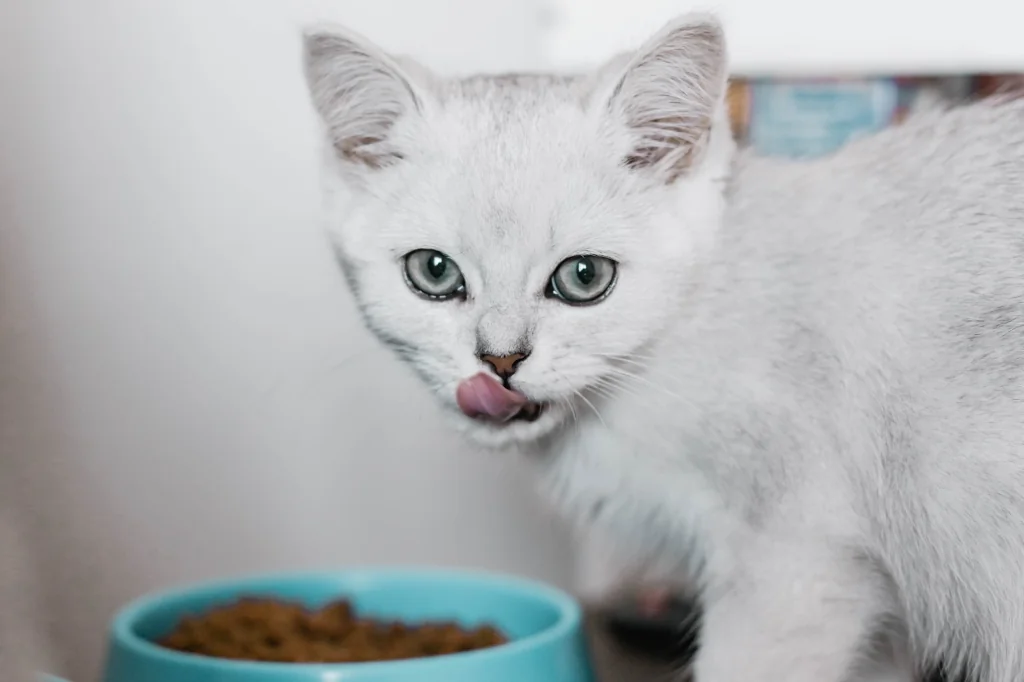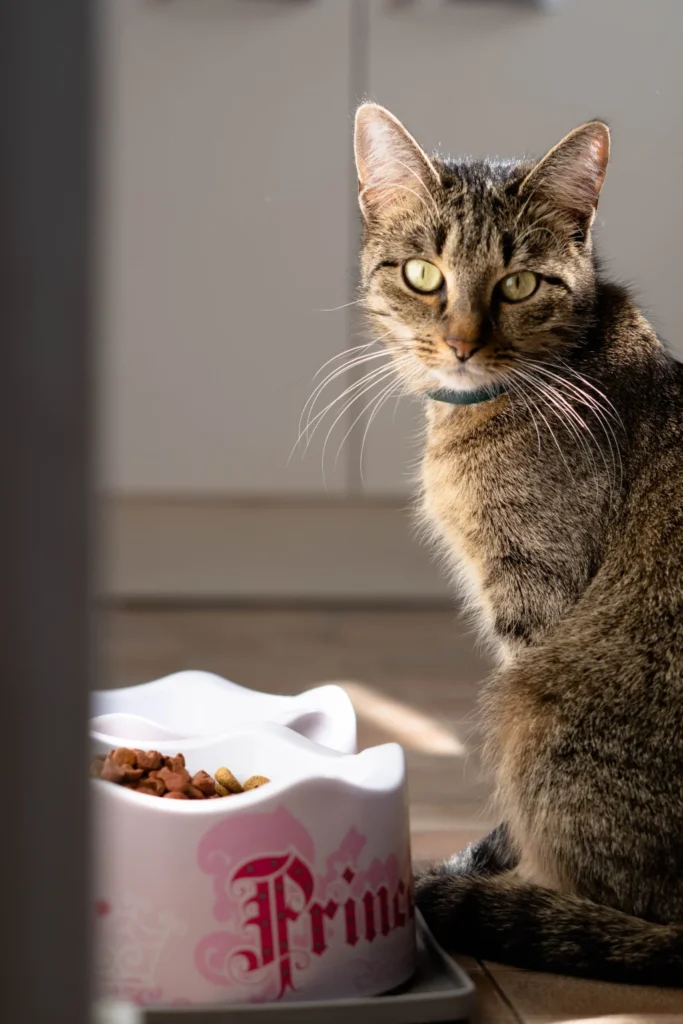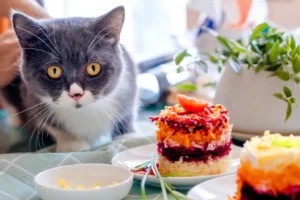Disclosure: We may earn a commission from helpful, relevant links in our content. No cost to you. See our privacy policy.
When a soft purring becomes the background music of your home, you know that the cat has truly chosen you as its companion.
And as cat owners, we know that maintaining their health is one of our top priorities. Among the dilemmas you might face is finding the right dry food to satisfy their palate and keep them in the pink of health.
Cats, with their picky nature and specific nutritional needs, present us with the challenge of balancing their tastes with their dietary needs. Let’s plunge into this guide together, where we’ll whisker you through how to select the ideal dry food for your feline friend.

Why Feed Your Cat Dry Food?
You may have seen your cat eagerly pounce on a crunchy kibble and wondered: why dry food?
Well, dry food carries some key advantages. For one, it’s convenient. The packaging is easy to store, and you can safely leave it out for ‘free feeding’ without worrying about it spoiling during the day. Plus, it’s often more cost-effective in the long run compared to wet food.
More importantly, dry food can aid in oral health. The process of chewing kibbles can help keep your cat’s teeth clean and reduce tartar buildup. However, it’s crucial to remember that dry food is not a substitute for regular dental care.
Lastly, dry food often comes in various shapes and sizes, which can provide a fun and stimulating eating experience for your cat. So, while feeding your cat, both the health benefits and fun factor are essential to consider.
What Type of Dry Cat Food Is Best for Your Cat?
Choosing the right dry cat food for your feline companion is a task that requires careful consideration. There’s a dizzying array of options on the market, each touting its unique benefits. Here are a few key factors to help you understand what type of dry cat food will be the best for your cat.
The Age Factor: Kitten, Adult, or Senior?
First off, consider the age of your cat.
Kittens need a diet rich in proteins and fats to support their rapid growth and high energy levels. Look for dry food specifically formulated for kittens, enriched with DHA, an omega-3 fatty acid that supports brain and eye development.
We recommend Hill’s Science Diet Dry Kitten Food. Rich in DHA for brain and eye development, it’s specifically formulated to meet the high-energy demands of growing kittens.
Adult cats, on the other hand, require a balanced diet to maintain their weight and overall health. There are many good choices to consider, with most top brands catering to different needs and cat preferences.
Senior cats, typically those over seven years old, need food rich in proteins but low in fat and calories to keep their weight in check and prevent diseases common in aging cats, like diabetes or kidney disease. They may benefit from a diet that includes joint-supporting nutrients like chondroitin and glucosamine.
For senior cats, Blue Buffalo Wilderness High Protein is a good choice. As their title says, it’s high in protein, low in fat, but also includes glucosamine and chondroitin for joint support.
Remember: Always match your cat’s food to their life stage, and consider specific additives like DHA for kittens or joint-supporting nutrients for older cats.
Related: Nutritional Needs from Kitten to Senior
Here’s a table of what to keep in mind about dry food relative to your cat’s age:
| Life Stage | Protein Content | Calorie Content | Key Nutrients | Potential Allergens |
|---|---|---|---|---|
| Kitten | High | High | DHA | Grain-based foods |
| Adult | Balanced | Balanced | Taurine | Artificial additives |
| Senior | High | Low | Chondroitin, Glucosamine | Grain-based foods, Artificial additives |
Size and Breed Matter
The size and breed of your cat also determine the type of dry food that’s best for them. Some brands produce breed-specific formulas.
For instance, certain breeds like Maine Coon or Persian cats have specific dietary requirements due to their size, fur density, and known health conditions. Hairball control is a more significant concern for these two breeds. For them, look out for dry foods with a high fiber content, which can help control hairball issues.
For breeds with specific dietary requirements, like Maine Coons, Royal Canin Maine Coon Breed dry cat food provides targeted nutrients, including fibers, to help control hairballs.
Reminder: Consider your cat’s breed and size when choosing food. Long-haired breeds might benefit from high-fiber formulas, while smaller breeds could do better with smaller kibble sizes.
Health Conditions and Dietary Restrictions
Some cats may have allergies, sensitivities, or intolerances to certain ingredients. If your cat has a specific health condition, specialized diets can be a godsend. There are hypoallergenic options and grain-free formulas that can work well for these cats.
- Cats with kidney disease might require food lower in phosphorous.
- Diabetic cats may do better with food high in protein and low in carbs.
- Cats with a history of urinary issues might benefit from food with controlled mineral levels to maintain urinary tract health.
If your cat has kidney disease, Hill’s Prescription Diet k/d Kidney Care Cat Food could be beneficial. It’s specially formulated with low phosphorus content to help support kidney function.
But remember to always consult your vet before switching your cat to a diet for a specific health condition.
Here’s a table of potential dietary restrictions based on health conditions:
| Health Condition | Protein Content | Calorie Content | Key Nutrients | Potential Allergens |
|---|---|---|---|---|
| Kidney Disease | Lower | Balanced | Low Phosphorous | High Phosphorous foods |
| Allergies | Depends on allergen | Balanced | Depends on allergen | Specific allergens |
| Diabetes | High | Low | Balanced | High carb foods |
| Urinary Issues | Balanced | Balanced | Controlled mineral levels | High mineral foods |
Quality and Nutritional Value
Not all cat food is created equal. Look for high-quality dry food that lists a source of animal protein as the first ingredient, as cats are obligate carnivores. The food should also contain taurine, an essential amino acid for cats.
Avoid foods with a long list of artificial colors, flavors, and preservatives.
As a unique tip, look for dry foods that contain probiotics. These beneficial bacteria can support your cat’s digestive health and boost their immunity.
Key Takeaways:
- The first ingredient should be a source of animal protein.
- The food should contain taurine, an essential amino acid for cats.
- Avoid food with artificial colors, flavors, and preservatives.
Taste and Texture Preferences
Some cats prefer specific shapes or textures in their dry food, while others might favor certain flavors.
Some cats may prefer a certain kibble shape due to their jaw structure or eating style. For example, flat-faced breeds like Persians might find round or flat-shaped kibbles easier to eat.
It may take some trial and error to find out what your cat likes best, but their enthusiastic purrs and clean food dish will let you know when you’ve hit the jackpot.

How to Choose Dry Cat Food for Your Cat?
Selecting the perfect dry cat food for your feline companion requires thoughtful considerations and careful steps. Here’s how you can do it.
Step 1: Assess Your Cat’s Individual Needs
Before rushing to the pet store, take a moment to evaluate your cat’s individual needs.
Consider their age, breed, size, and health condition. Make a note of any specific dietary requirements or restrictions they might have. The dry cat food you choose should meet these individual needs.
Make sure to observe your cat’s daily activities as well, as active outdoor cats may require more calories compared to indoor cats. Also, if your cat has a longer coat, a diet rich in omega fatty acids can help maintain a glossy fur.
Dry Food Cat Calorie Intake Calculator
In addition to considering your cat’s age, breed, size, and health condition, you also need to assess their caloric needs. This will help you understand how much dry food you should be feeding your cat each day. To help you estimate this, you can use our simple Cat Calorie Intake Calculator.
Estimate your cat’s daily calorie needs based on their weight using our simple calculator. Just enter your cat’s weight in pounds and click “Calculate”.
Enter your cat’s weight (in pounds):
? Note: This calculator estimates the calorie needs of cats at a healthy weight. If your cat is overweight, feeding them based on their current weight could lead to overfeeding. Instead, use their target weight, which is the weight they would be at a healthy size.
Please remember that there can be wide variations in caloric content among dry cat foods, so it’s always best to consult the specific information provided by the cat food manufacturer, as well as your vet.
Step 2: Look for High-Quality Ingredients
Next, always check the ingredient list. The primary ingredient should ideally be a source of animal protein. Beware of foods where fillers, such as corn or soy, dominate the top spots.
Also, remember that cats require taurine, an essential amino acid, in their diet. It’s usually included in commercial cat food, but double-checking won’t hurt.
Related: Guide to Ingredient List on Cat Foods
Step 3: Say No to Unnecessary Additives
Stay clear of foods that are loaded with artificial colors, flavors, and preservatives. These might make the food look and smell more appealing, but they offer no nutritional value to your cat. In some cases, they might even lead to health issues.
Be cautious about additives like:
- BHA,
- BHT, and
- ethoxyquin.
Though they act as preservatives, there is concern about their safety for cats.
Food colorings like:
- Yellow 5 and 6,
- Red 40, and
- Blue 2
should also be avoided. While these are generally considered safe, their nutritional value is nonexistent, and they can cause allergies in some cats.
Step 4: Consider Palatability
Your cat’s opinion matters, too. Even the healthiest food won’t benefit your cat if they refuse to eat it. If they turn their nose up at the new food, don’t force it. You might need to try a few different brands or flavors before finding one that your cat loves.
Related: Top Cat Food Brands Reviewed
Step 5: Seek Professional Advice
When in doubt, ask a professional. Your vet can provide advice based on their understanding of your cat’s health and needs. If your cat has a health condition, the vet might recommend a prescription diet or specific brands.
Veterinarians have access to the latest research and nutritional guidelines, ensuring their advice is scientifically sound and up-to-date. Regular check-ups can also help your vet monitor changes in your cat’s health over time, which could necessitate dietary changes.
Remember, some conditions may not show noticeable symptoms but could still affect your cat’s dietary needs.
Step 6: Gradual Transition
Once you’ve selected the new dry cat food, introduce it gradually to your cat. Start by mixing a small amount of the new food with the old. Over a week or two, slowly increase the proportion of the new food.
This gradual transition will help your cat adjust to the change and reduce the risk of digestive issues.
By following these steps, you’ll be well on your way to choosing a dry cat food that keeps your feline friend both happy and healthy. It’s all about finding the right balance for your particular kitty.
Do Cats Need Variety in Dry Food?
Much like us, cats can also appreciate a bit of variety in their diet. However, they do not need variety for the same reasons humans do. Their nutritional needs can be consistently met with the same balanced diet.
That being said, there can be benefits to introducing some variety in the form of different flavors or textures, particularly for finicky eaters.
A novel approach is to use rotational feeding, where you switch between a few high-quality dry foods every few months. This can help avoid flavor fatigue and ensure a broader nutrient intake.
What Do Experts Recommend?
Experts often emphasize the importance of quality over quantity.
They recommend dry cat food that’s rich in animal proteins and low in carbohydrates, with minimal fillers and artificial additives. Some also advise incorporating wet food into your cat’s diet, as it helps increase their water intake and reduce the risk of urinary problems.
As an experienced cat owner and researcher, I’ve found that following these guidelines, while also taking into account your cat’s specific needs and preferences, leads to the best outcomes in feline health and happiness.
Overall, a well-balanced option for most cats is the Purina ONE Indoor Advantage Adult Dry Cat Food. It’s rich in protein, with turkey as the first ingredient, and contains beneficial fiber for hairball control.
When it comes to choosing the right dry cat food for your cat, your intuition as a pet parent plays a crucial role. Trust your understanding of your cat’s likes and dislikes, and don’t be disheartened if you need to try a few different options. Remember, with a little patience and persistence, you’re sure to find the meal that will have your feline purring with satisfaction.
FAQs
Does high-quality cat food make a difference?
High-quality cat food does make a significant difference. It is usually rich in animal proteins, includes essential nutrients like taurine, and contains fewer fillers and artificial additives, which contributes to your cat’s overall health and longevity.
Is there a risk of dehydration with dry cat food?
While dry cat food is convenient and has a longer shelf life, it contains less moisture than wet food. Therefore, cats fed exclusively on dry food need access to fresh water at all times to avoid the risk of dehydration. Many cat owners also incorporate wet food into their cat’s diet to increase hydration.
Can kittens eat the same dry food as adult cats?
Feeding kittens the same dry food as adult cats isn’t recommended. Kittens have different nutritional needs, requiring a diet high in protein and fat to support their growth and development. So, it’s best to choose a dry food specifically formulated for kittens.
Alex, a passionate animal lover, has experience in training and understanding animal behavior. As a proud pet parent to two dogs and three cats, he founded AnimalReport.net to share insights from animal experts and expand his knowledge of the animal kingdom.




